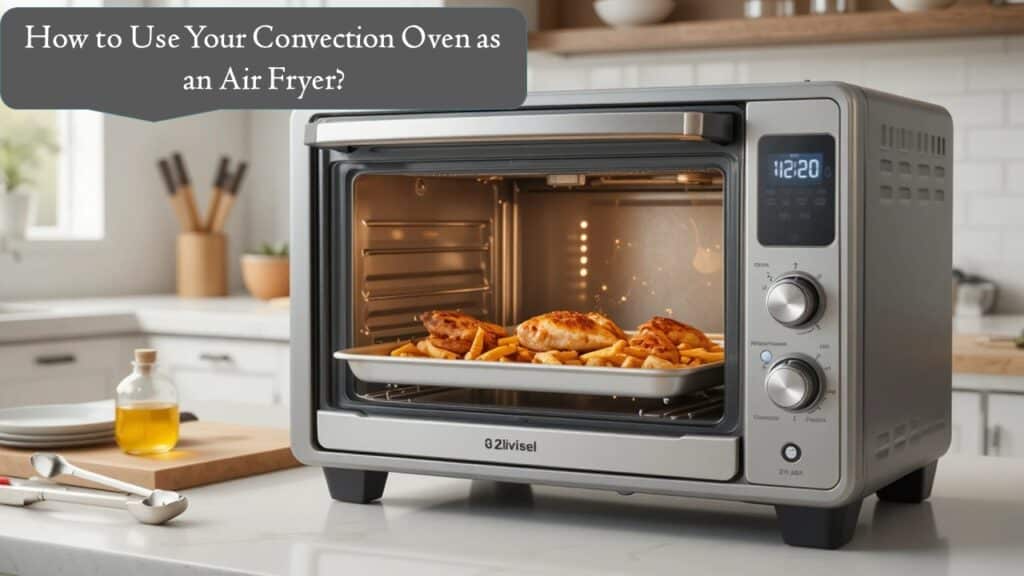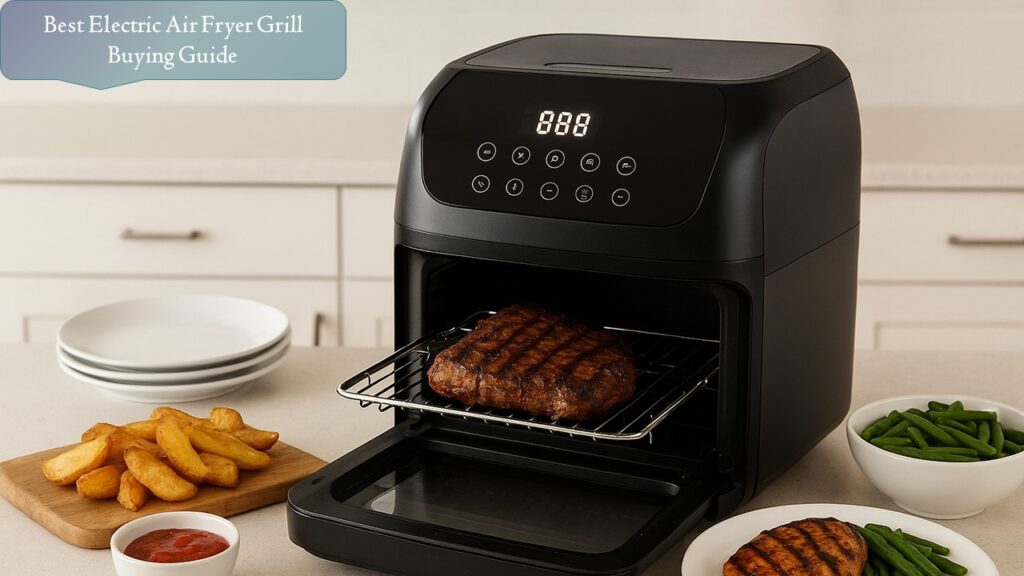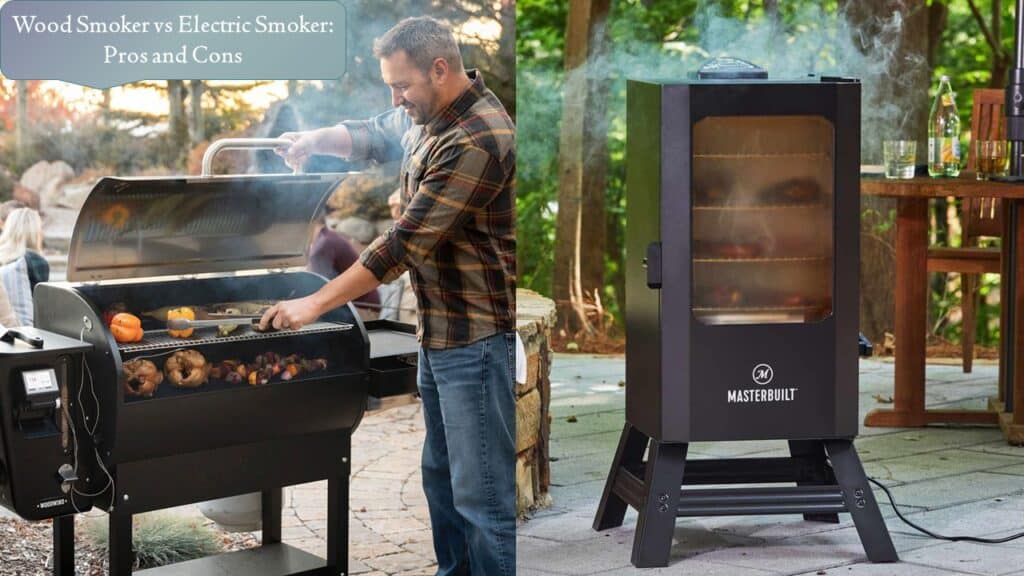If you’ve ever wished for crispy fries or golden chicken wings without buying yet another kitchen gadget, here’s some good news — you probably already own an air fryer. Yes, your convection oven can absolutely double as an air fryer. Both use hot air circulation to cook food evenly and achieve that signature crunch we all love.
So, before you rush out to buy a new appliance, let’s explore how to use your convection oven as an air fryer the right way — with practical tips, ideal settings, and techniques that deliver perfectly crispy results every time.
What Makes a Convection Oven Similar to an Air Fryer?
Both convection ovens and air fryers use rapid hot air circulation to cook food. A convection oven has a built-in fan and exhaust system that blows hot air around your food, creating even heat distribution — the same principle that gives air fryers their crispiness.
The main difference lies in size and airflow intensity:
- Air fryers are compact, meaning the fan is closer to your food and circulates air more aggressively.
- Convection ovens are larger, so you might need a bit more time and the right setup to get identical results.
But with the right tweaks, your convection oven can mimic an air fryer’s performance beautifully — saving you counter space and money.
What You’ll Need Before You Start?
To get the most out of your convection oven, a few simple tools make all the difference:
- A wire rack or air-fry basket: For optimal airflow under your food.
- A baking sheet: To catch drips and crumbs.
- Parchment paper (optional): For easy cleanup, but avoid covering the rack fully — air needs to circulate.
- A light coating of oil: For that irresistible crisp texture.
- Tongs: For flipping food safely halfway through.
Step-by-Step Guide: How to Use Your Convection Oven as an Air Fryer
Step 1: Preheat Your Oven
Just like an air fryer, a convection oven performs best when it’s preheated.
Set your oven to 25°F lower than the temperature you’d normally use in a recipe meant for an air fryer.
For example:
If the air fryer recipe says 400°F, set your convection oven to 375°F.
This adjustment ensures your food cooks evenly without drying out or burning the edges.
Step 2: Position Your Oven Rack Correctly
The middle rack position usually works best for air frying, as it allows for even heat distribution.
If you’re cooking something that needs extra crisping (like fries or chicken wings), you can move the rack slightly higher to bring it closer to the fan.
Step 3: Arrange Food Properly
Space is key! Whether you’re making potato wedges, chicken tenders, or vegetables, spread them in a single layer on the wire rack.
Avoid overcrowding — it blocks airflow and leads to uneven cooking.
Pro Tip:
If you’re cooking multiple batches, it’s better to do two smaller ones than one big overcrowded tray.
Step 4: Adjust Cooking Time
Since convection ovens are larger and circulate air slightly slower than air fryers, you might need to extend cooking times by 3–5 minutes.
Here’s a simple conversion guide:
| Food Type | Air Fryer Time | Convection Oven Time |
| French Fries | 15 minutes at 400°F | 18–20 minutes at 375°F |
| Chicken Wings | 20 minutes at 390°F | 25 minutes at 365°F |
| Vegetables | 10 minutes at 380°F | 13–15 minutes at 355°F |
| Fish Fillets | 12 minutes at 375°F | 15 minutes at 350°F |
| Nuggets/Tenders | 10 minutes at 400°F | 13–14 minutes at 375°F |
Remember: Each oven model varies, so keep an eye on your first few attempts and tweak timing as needed.
Step 5: Flip or Shake Halfway Through
Just like in an air fryer, flipping food halfway through ensures every side gets evenly crispy. Use tongs for larger items or shake the tray gently if you’re cooking fries or small pieces.
This step makes a huge difference in texture — no soggy bottoms or uneven browning.
Step 6: Keep It Light on the Oil
One of the best parts about air frying (and convection cooking) is that you don’t need much oil.
Use a spray bottle or brush to lightly coat your food. A thin layer is enough to help it brown and crisp beautifully without turning greasy.
Avoid aerosol cooking sprays with added chemicals — they can damage your oven’s finish. Instead, opt for pure oil sprays or use an oil mister.
Step 7: Use the Convection or Air Fry Setting (If Available)
Many modern convection ovens now come with an “Air Fry” or “Convection Roast” setting. If yours does, use it — this mode automatically controls the fan speed and temperature to simulate air-frying conditions.
If not, simply use convection bake mode and manually adjust the temperature as discussed earlier.
Tips for Perfect Results Every Time
To really master the art of air frying in your convection oven, keep these expert tips in mind:
- Always preheat for even cooking.
- Keep airflow unrestricted — use racks and avoid stacking.
- Line the bottom tray, not the rack. Catch drips, but don’t block air circulation.
- Don’t open the door too often. Each time you do, you lose heat and airflow consistency.
- Experiment with smaller portions first. Every oven behaves differently, so test timing on small batches.
- Finish with a quick broil (optional). For extra crispiness, switch to broil for the last 1–2 minutes — but watch closely to avoid burning.
Foods That Work Best in a Convection Oven Air Fry Setup
Not every food reacts the same way to convection air-frying. Here are some that turn out exceptionally well:
Crispy Favorites
- French fries or potato wedges
- Breaded chicken tenders or nuggets
- Onion rings
- Mozzarella sticks
Healthy Snacks
- Kale chips or chickpeas
- Roasted Brussels sprouts
- Sweet potato fries
- Cauliflower bites
Quick Proteins
- Salmon fillets
- Shrimp
- Thin pork chops or chicken breasts
These foods all benefit from the convection fan’s dry, circulating heat — producing crisp exteriors and tender interiors.
Cleaning and Maintenance Tips
Cooking without excess oil means less mess, but it’s still important to clean regularly for consistent results:
- Wipe the oven interior with a damp cloth after each use.
- Clean the racks and trays with warm, soapy water to remove grease residue.
- Avoid harsh cleaners or abrasive sponges that could damage the oven’s finish.
- Check fan vents occasionally for crumbs or grease buildup — this keeps airflow optimal.
A clean oven performs better, distributes heat more evenly, and keeps that crispy magic alive.
Common Mistakes to Avoid
Even with the right tools, a few small missteps can ruin your results. Avoid these common pitfalls:
- Skipping preheating: Leads to uneven cooking.
- Using too much oil: Can cause smoke and soggy food.
- Crowding the rack: Prevents air from circulating properly.
- Cooking at the same temperature as air fryer recipes: Results in over-browning.
- Ignoring the fan mode: Without convection, your food won’t crisp evenly.
A little attention to these details goes a long way toward getting restaurant-quality results right at home.
Conclusion:
Turning your convection oven into an air fryer isn’t just possible — it’s practical, efficient, and incredibly satisfying. You get all the crispy, golden textures you love from air frying without needing another bulky countertop appliance.
By adjusting your temperature slightly, using the right rack setup, and keeping portions manageable, your convection oven can deliver delicious, air-fried meals every time.
So, next time you crave crunchy fries or crispy chicken, skip the deep fryer — your convection oven has got you covered.







